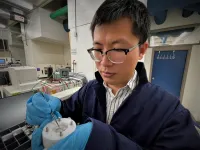The study, forthcoming in the Journal of Marketing, is titled "Informational Challenges in Omnichannel Marketing Remedies and Future Research" and is authored by Koen Pauwels, Haitao (Tony) Cui, Catherine Tucker, Raghu Iyengar, S. Sriram, Anindya Ghose, Sriraman Venkataraman, and Hanna Halaburda.
In this new study in the Journal of Marketing, researchers define omnichannel marketing as the "synergistic management of all customer touch points and channels both internal and external to the firm that ensures that the customer experience across channels and firm-side marketing activity, including marketing-mix and marketing communication (owned, paid, and earned), is optimized."
Often viewed as the panacea for one-to-one marketing, omnichannel experiences data, marketing attribution, and consumer privacy frictions. The research team demonstrates that advances in machine learning (ML) and blockchain can address these frictions. However, these technologies may in turn also present new challenges for firms and opportunities for academic research.
First, tofully realize the potential of omnichannel marketing, firms need information on all their interactions with each customer as they traverse the different stages of the customer journey. The study considers the whole gamut of interactions, such as communications between the firm and its customers, activities where the customers interact with the firm (or its partners) across information gathering, purchases, product fulfillment, returns, and post-purchase service. Such data might not be readily available or usable.
Questions for future research include: How to decide which machine-learning methods are best and can impute missing pieces of information using data already available to the firm? What is the optimal design of matchmakers/platforms that collect information from different parties spanning different customer touch points? What is the impact of data sharing within and across firms on consumers (prices they pay), firms (supply-chain efficiency, profit margins), and policy makers (market structure, efficiency, and overall surplus)? How to incentivize internal and external partners to participate in the blockchains? And might blockchain-enabled omnichannel marketing efforts increase or soften competition?
Second, advances in attribution modeling have significantly improved firms' ability to assign credit to a specific marketing touchpoint. However, extant attribution models are limited by an inability to attribute the transition to a single intervention or they presume that the impact of the previous intervention stops with the next step within the purchase funnel and does not carry over to subsequent steps within the funnel. Moreover, future research should develop attribution models that combine micro and macro data leveraging tried-and-tested methods in economics and marketing. Pauwels says that "We need more research that compares aggregate-level approaches using traditional attribution modeling with individual-level approaches and multi-touch attribution. It is useful to compare how extant attribution methods may be adapted to study forward-looking metrics such as customer lifetime value (CLV), which quantifies revenue streams a firm expects to earn after acquiring a customer." Finally, as omnichannel marketers adopt technologies like blockchain, firms will realize greater transparency and more reliable integration of consumer data across touchpoints within and outside of the firm. This naturally warrants a better understanding of how attribution effects change with and without blockchain-enabled marketing platforms.
Third, consumer privacy is advanced by regulation, customer empowerment, and blockchain guarantees. Still, there are several questions about how to improve consumer privacy. Is it possible to use predictive analytics in a manner that is conscious of consumers' likely privacy preferences? Moreover, is there a way of emulating existing blockchain-based ecosystems in an omnichannel context? For example, can a firm use blockchain to create a token that establishes a currency that allows consumers to be rewarded for sharing their data as a part of an omnichannel marketing effort? And more ambitiously, is there a way that multiple firms can coordinate around a single-token-based scheme to help kickstart a larger ecosystem? How successful are ad-tech initiatives that have helped omnichannel marketers become privacy-regulation compliant? Are they inherently just a cost that interrupts the accurate processing of information or are there benefits in terms of enhanced consumer trust? Academic-firm partnerships can assess the usefulness of such tools for firms, consumers, and regulatory compliance - as well as make recommendations for improvements. Recent developments in federated learning aim to provide privacy controls; however, there remains room for indirect leakage of consumer information. These leakages can stem from loopholes in collaborative machine-learning systems, whereby an adversarial participant can infer membership as well as properties associated with a subset of the training data. In a blockchained federated-learning architecture, the local-learning model updates are exchanged and verified by leveraging a blockchain. Might such developments temper privacy concerns and lead to more efficient omnichannel marketing programs?
Finally, public policy has thus far focused on the deleterious effects of machine-learning-induced algorithmic biases, such as racial or gender discrimination. Cui explains that "There is scant research or policy looking at the use of personal information in algorithms. For example, does greater transparency into the customer's path-to-purchase journey, even with explicit customer consent, result in the unintended consequence of giving omnichannel firms room to price-discriminate efficiently, and in doing so, erode consumer welfare?"
INFORMATION:
Full article and author contact information available at: https://doi.org/10.1177/0022242920968810
About the Journal of Marketing
The Journal of Marketing develops and disseminates knowledge about real-world marketing questions useful to scholars, educators, managers, policy makers, consumers, and other societal stakeholders around the world. Published by the American Marketing Association since its founding in 1936, JM has played a significant role in shaping the content and boundaries of the marketing discipline. Christine Moorman (T. Austin Finch, Sr. Professor of Business Administration at the Fuqua School of Business, Duke University) serves as the current Editor in Chief.
https://www.ama.org/jm
About the American Marketing Association (AMA)
As the largest chapter-based marketing association in the world, the AMA is trusted by marketing and sales professionals to help them discover what is coming next in the industry. The AMA has a community of local chapters in more than 70 cities and 350 college campuses throughout North America. The AMA is home to award-winning content, PCM® professional certification, premiere academic journals, and industry-leading training events and conferences.
https://www.ama.org


